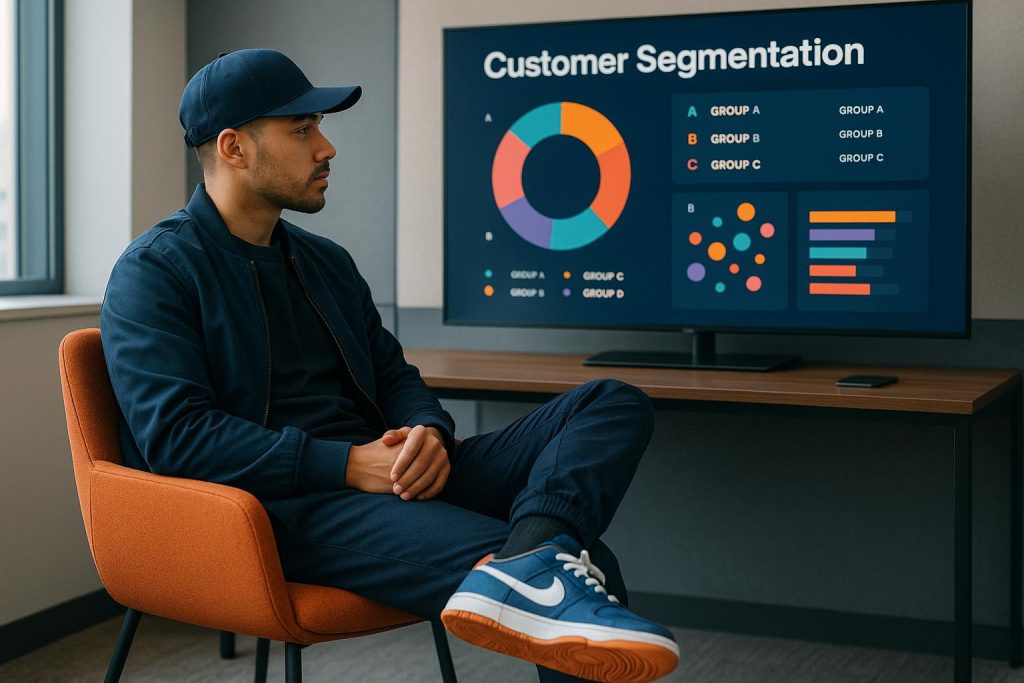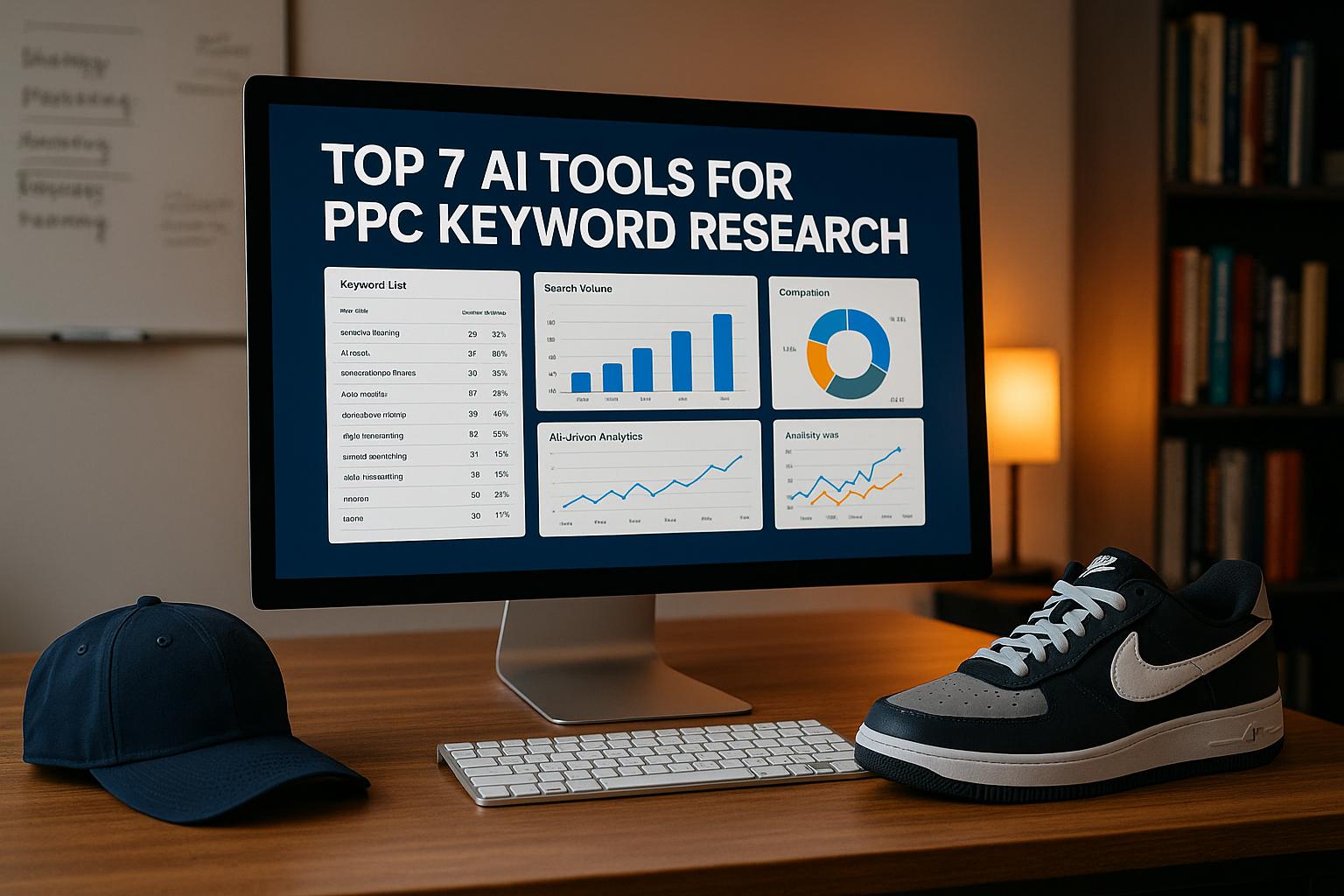AI is transforming customer segmentation in 2025, moving beyond outdated demographic-based methods to real-time, data-driven strategies. Businesses now use AI to create precise, behavior-focused customer groups, improving marketing results and customer experiences. Key trends include:
- Real-time personalization: AI tailors messages instantly based on customer actions, boosting engagement and sales.
- Privacy-focused solutions: Tools now balance personalization with compliance, building trust with customers.
- Integrated data insights: AI combines behavioral, transactional, and demographic data for a complete customer view.
- Explainable AI: Transparent decision-making helps teams trust AI insights and refine strategies.
Companies leveraging these trends see better ROI, stronger customer loyalty, and improved retention. However, challenges like data quality, integration, and compliance remain. To succeed, focus on clean data, the right tools, and continuous monitoring.
Takeaway: AI-powered segmentation delivers unmatched precision, enabling businesses to connect with customers on a deeper level while navigating privacy regulations confidently.
AI-Powered ICP & Customer Segmentation in 2025 | upGrowth
How Customer Segmentation Has Changed
The move from traditional to AI-powered customer segmentation has completely redefined how businesses understand and target their audiences. What was once a static, assumption-based process has evolved into a dynamic, data-driven strategy. This shift highlights the flaws of older methods while showcasing the strengths of AI.
Problems with Traditional Segmentation
Traditional segmentation leaned heavily on static demographics, which simply couldn’t keep up with the fast-paced changes in customer behavior. These methods required manual analysis of basic data, making them time-consuming, resource-intensive, and hard to scale.
Marketing teams were typically limited to managing just 3–8 segments. This meant millions of customers were grouped together based on surface-level similarities, ignoring deeper, more meaningful differences in their preferences and actions.
Another major drawback was the lack of real-time insights. Segmentation updates were rare – happening quarterly or even annually. By the time marketers implemented their findings, customer preferences had often shifted, rendering the data outdated.
Bias was another issue. Marketers frequently relied on subjective assumptions when defining segments, leading to inaccurate customer profiles that failed to capture emerging trends. Analysts would spend weeks combing through data and generating reports, eating up time and budgets that could have been better spent on actual marketing efforts.
Benefits of AI-Driven Segmentation
AI-powered segmentation solves these challenges by offering capabilities that traditional methods simply couldn’t match. For starters, AI processes massive datasets in minutes, analyzing thousands of variables at once to uncover patterns that would otherwise go unnoticed.
AI also updates segmentation in real time. As customer behaviors shift, the system adjusts automatically, ensuring that businesses always have an up-to-date understanding of their audience – no manual input required.
This technology goes beyond the obvious, identifying micro-segments that human analysts might overlook. For example, AI can detect a group of customers who browse premium products on their phones but tend to make purchases only on weekends.
Another game-changer is AI’s predictive power. It doesn’t just analyze past behavior; it forecasts future actions. This means businesses can spot customers likely to churn, identify those ready to upgrade, or even target segments showing early interest in new products.
AI’s scalability is also unmatched. While traditional methods could only handle a handful of broad segments, AI manages thousands of micro-segments simultaneously, each with its own tailored strategies and recommendations.
Traditional vs. AI-Driven Segmentation
| Factor | Traditional Segmentation | AI-Driven Segmentation |
|---|---|---|
| Speed | Weeks to months for updates | Real-time processing and updates |
| Scalability | 3–8 broad segments maximum | Thousands of micro-segments |
| Data Processing | Limited to basic demographics | Includes behavioral, transactional, and contextual data |
| Accuracy | Based on assumptions | Data-driven with continuous learning |
| Resource Requirements | Extensive manual effort | Minimal human intervention required |
| Adaptability | Static, infrequent updates | Dynamic, continuous adjustment |
| Predictive Power | Reactive, past data only | Proactive, forecasts future behavior |
| Personalization Level | Broad, one-size-fits-many | Hyper-personalized, individual-level insights |
This transformation has leveled the playing field. Now, even small businesses can access advanced customer insights that were once exclusive to large enterprises with dedicated analytics teams. The result? Smarter marketing campaigns, better customer experiences, and a stronger return on investment.
This evolution in segmentation sets the stage for the advanced AI-driven strategies shaping the future of marketing. Stay tuned as we dive into these emerging trends next.
Top AI Customer Segmentation Trends for 2025
AI-powered marketing is on a steep growth curve, with projections showing an increase from $27.83 billion in 2024 to $35.54 billion in 2025, growing at a 27% compound annual growth rate (CAGR). This rapid expansion is driving four major trends that are reshaping how businesses engage with and understand their customers.
Hyper-Personalization and Real-Time Data
Gone are the days when generic marketing messages could get the job done. Today’s customers expect highly tailored experiences, and AI is stepping in to meet those expectations. In fact, 71% of consumers now anticipate personalized interactions, while 76% report feeling frustrated when businesses fail to deliver them.
The payoff for businesses embracing personalization is substantial. Companies using customer behavioral insights to tailor their outreach are seeing an 85% boost in sales growth and over a 25% increase in gross margins. Personalized websites, for instance, achieve conversion rates of about 19%, compared to just 2.9% for non-personalized ones.
To deliver this level of precision, AI systems rely on real-time data processing. These tools analyze customer behavior as it unfolds – tracking clicks, purchases, browsing habits, and interactions across various channels. For example, an abandoned shopping cart can instantly trigger a personalized recovery campaign. Such efforts can increase revenues by 5% to 15% and improve marketing ROI by 10% to 30%.
Privacy and Data Compliance
As personalization becomes more advanced, concerns about privacy are growing. Businesses must navigate these challenges by building trust while adhering to evolving regulations. In the U.S., laws like the California Consumer Privacy Act (CCPA) are setting new benchmarks for how companies manage customer data.
To address these concerns, businesses are adopting methods that allow them to gain insights from customer data without exposing sensitive information. Transparency plays a critical role here. Companies that clearly explain their data practices and empower customers to control their own information are more likely to earn trust and foster stronger engagement.
Combining Multiple Data Types
AI segmentation tools are revolutionizing how businesses handle data by consolidating behavioral, transactional, and demographic information into unified customer profiles. This integrated approach uncovers patterns and insights that traditional analyses often miss.
The impact has been striking: 87% of organizations using advanced segmentation have reported significant improvements in customer engagement. By combining diverse data sources – like purchase histories, browsing behaviors, and social media activity – AI provides the context and timing needed for effective, real-time actions. However, achieving this level of sophistication requires robust data management, regular audits, and reliable identity resolution to ensure that data is accurately linked to individual customers.
Clear AI Explanations for Better Trust
As AI-driven segmentation becomes more sophisticated, the need for transparency in its decision-making processes grows. Explainable AI offers clear insights into how decisions are made, helping marketing teams understand and trust the system. Instead of just providing a recommendation, these tools explain the factors that led to specific insights.
This clarity not only boosts confidence within marketing teams but also helps identify and address potential biases in the algorithms. Additionally, as data regulations become stricter, having interpretable decision-making processes can help companies stay compliant while refining their strategies.
Together, these trends are shaping a new era of customer segmentation – one that’s precise, privacy-aware, and deeply data-driven. Businesses that leverage these advancements will be well-positioned to thrive in 2025 and beyond. The next section will explore how these trends translate into measurable business outcomes.
sbb-itb-d6d4d8b
Business Results: Using AI for Growth
AI has moved beyond being a buzzword – it’s now a driver of real business growth. By leveraging advanced segmentation techniques, companies are seeing measurable improvements in profitability, stronger customer relationships, and streamlined operations across various industries.
Better ROI Through Targeted Campaigns
AI-powered segmentation ensures that marketing campaigns hit the right audience at the right time, significantly improving return on investment (ROI). For instance, businesses using AI to fine-tune their email campaigns often see higher open and click-through rates, leading to better conversion outcomes.
By zeroing in on high-potential customer segments, businesses can optimize their ad spend, cut down on customer acquisition costs, and attract more qualified leads. AI insights also supercharge cross-selling and upselling efforts by pinpointing customers most likely to purchase additional products or upgrade services. These targeted approaches consistently outperform broad, generic campaigns, delivering higher response rates and, ultimately, boosting revenue.
The ripple effect? Enhanced customer engagement and loyalty that keep customers coming back.
Stronger Customer Engagement and Loyalty
When brands tailor their communications and offers to match individual customer preferences, the results are clear: better engagement and stronger loyalty. Customers are more likely to stick around, make repeat purchases, and even recommend the brand to others.
AI also helps businesses stay ahead of potential churn. By identifying early warning signs – like changes in buying behavior or reduced product usage – companies can act quickly with retention strategies that are more effective than waiting until it’s too late.
Loyalty programs benefit as well. AI ensures rewards are personalized, which encourages greater participation and makes customers feel valued. On the support side, AI insights empower teams to deliver tailored assistance, improving overall satisfaction and strengthening the relationship between customers and the brand.
Common Implementation Challenges
While the benefits of AI are undeniable, implementing it isn’t always smooth sailing. Companies face several challenges that need to be addressed for long-term success.
| Advantages | Challenges |
|---|---|
| Pinpoint targeting – identify niche customer groups for better conversions | Data quality issues – AI needs clean, consistent data to work effectively |
| Real-time personalization – adjust messages instantly based on customer behavior | Technical hurdles – integrating AI with existing systems demands IT expertise |
| Scalable insights – analyze large volumes of customer data without added manpower | High upfront costs – advanced AI tools require significant initial investment |
| Predictive insights – anticipate customer needs for proactive marketing | Training requirements – teams need to learn how to use and interpret AI tools |
| Consistent messaging – maintain a seamless experience across channels | Privacy concerns – staying compliant with regulations while personalizing experiences |
| Automated optimization – improve campaigns with minimal manual input | Resistance to change – transitioning to data-driven decision-making can be tough |
To navigate these challenges, many businesses take a phased approach, starting small and scaling AI initiatives over time. Budget planning is critical, but the long-term gains in efficiency, customer satisfaction, and revenue often outweigh the upfront costs.
The key to success lies in combining the power of AI with skilled, well-trained teams. By investing in employee training and embracing data-driven insights, businesses can unlock sustained growth and stay ahead in today’s competitive landscape.
How to Implement AI Customer Segmentation
Implementing AI customer segmentation requires a structured approach, solid data systems, and scalable processes. The key to success lies in using high-quality data, selecting the right tools for your needs, and keeping your AI systems updated over time.
Data Quality and Integration Needs
AI-powered segmentation thrives on accurate, well-integrated data. This means pulling customer information from all available touchpoints – like website analytics, CRM systems, email platforms, and social media channels – into a unified system.
One of the biggest hurdles here is dealing with data silos. When customer data is scattered across separate systems that don’t communicate, it’s tough for AI tools to create complete customer profiles. For example, one platform might track email engagement while another logs browsing behavior. Without integration, you could miss opportunities to tailor messages for customers showing high purchase intent.
To address this, standardize and clean your data. This might involve merging duplicate records (e.g., combining "John Smith" and "J. Smith") and ensuring consistency across formats. Many successful projects start with a data audit to identify duplicates, formatting issues, and gaps in governance. This groundwork is crucial for creating accurate, real-time customer profiles that AI tools can rely on.
Selecting the Right AI Tools
Choosing the right AI segmentation tool depends on your technical expertise, budget, and growth goals.
- For small businesses and start-ups, tools built into existing marketing platforms are often the best starting point. These solutions are easy to set up, handle basic segmentation tasks, and automate communications effectively.
- Mid-sized companies may need platforms capable of managing larger data sets and offering advanced features like predictive analytics. These tools can help identify trends such as potential customer churn or repeat purchases. Costs will vary depending on the volume of data and the features you need.
- Enterprise organizations often require custom AI solutions or advanced platforms that can process millions of records and integrate with existing tech stacks. These tools typically take longer to implement and need ongoing technical support.
When evaluating tools, look for options that integrate seamlessly with your current systems, scale alongside your business, and provide transparency in how they group customers. Tools that explain their decisions make it easier for your team to act on insights. Once implemented, keep monitoring these tools to ensure they stay aligned with changing customer behaviors.
Monitoring and Adjusting Your System
AI segmentation isn’t a one-and-done process – it requires constant monitoring and fine-tuning as customer preferences and market conditions shift.
Start by setting performance benchmarks. Track metrics like segment stability, campaign performance by segment, and overall engagement levels to gauge how well your segmentation is working. Regular reviews can help you spot changes in customer behavior early and adjust your strategies accordingly.
Be aware of segment drift. For example, a group initially labeled as "budget-conscious" might evolve over time due to changes in the economy. Ongoing analysis ensures your segmentation remains relevant.
Additionally, keep privacy regulations in mind. Laws such as GDPR and CCPA require that your AI respects customer data preferences, handles deletion requests properly, and maintains clear audit trails. Building compliance monitoring into your strategy is essential to stay on the right side of these regulations.
Finally, use A/B testing to continually refine your approach. Experiment with different messages and strategies to see what resonates most with each segment. This helps you optimize results and validate the effectiveness of your AI-driven segmentation.
For more tips and expert advice on segmentation strategies, visit JeffLizik.com.
Conclusion: Main Points and Next Steps
AI-powered customer segmentation has become a cornerstone of marketing strategies as we approach 2025. The move away from traditional demographic-based groupings to real-time, behavior-driven segmentation is reshaping how businesses connect with their audiences and drive revenue growth.
The trends we’ve explored – like hyper-personalization, privacy compliance, and seamless data integration – are proving to be game-changers. Companies adopting these advancements are seeing stronger campaign results and deeper customer engagement. On the flip side, businesses clinging to outdated methods risk losing their competitive edge.
To succeed, businesses need to focus on three critical areas: maintaining clean, integrated data; selecting AI tools that align with their business needs; and staying vigilant by regularly updating segments to reflect changing customer behaviors.
The companies thriving in 2025 understand that AI segmentation isn’t just about data – it’s about creating personalized customer experiences that foster loyalty and long-term value. Whether you’re a startup or a large enterprise, the right AI-driven approach can deliver measurable results and set you apart.
Now’s the time to refine your segmentation strategy. With strategic planning and expert insights, you can stay ahead of the curve. JeffLizik.com offers tailored digital marketing consulting services, including AI-driven marketing system development and detailed 12-month marketing plans. Take the first step toward leveraging these trends – start building your AI segmentation strategy today.
FAQs
How does AI-driven customer segmentation balance personalization with privacy regulations?
AI-powered customer segmentation manages to blend personalization with privacy by following important regulations such as GDPR and CCPA. These laws emphasize the need for transparency, obtaining user consent, and limiting data collection to what’s absolutely necessary – ensuring that customer information is treated with care and responsibility.
By incorporating privacy-by-design strategies, performing regular risk evaluations, and safeguarding data through strong security measures, AI tools can create customized experiences without compromising user privacy. This not only helps maintain compliance with legal and ethical guidelines but also strengthens trust, promoting a marketing approach that genuinely prioritizes the customer.
How can small businesses start using AI-powered customer segmentation without needing advanced technical skills?
Small businesses can take advantage of AI-powered customer segmentation by leveraging no-code AI tools. These tools are built with user-friendly interfaces and provide step-by-step instructions, making it simple for non-technical users to analyze customer data and create precise audience segments.
On top of that, AI-driven marketing tools – like chatbots and content automation – can help streamline the entire segmentation process. These solutions are easy to set up and enable small businesses to make informed, data-based decisions without needing advanced technical skills.
What steps can businesses take to address data quality and integration issues for effective AI-driven customer segmentation?
To address the challenges of data quality in AI-driven customer segmentation, businesses need to break down data silos and establish strong data governance practices. This means ensuring that data is consistently collected, cleaned, and integrated across all customer interactions. High-quality data starts with a unified approach.
One effective way to achieve seamless data integration is by using cloud-based platforms and automated tools. These solutions help unify data from various sources, making it easier to analyze and act on. A well-structured data strategy that emphasizes real-time insights and ongoing refinement can amplify the impact of AI, enabling it to create more precise and actionable customer segments.
By tackling these issues head-on, companies can harness AI’s full potential to sharpen their marketing efforts and build stronger connections with their audiences.








